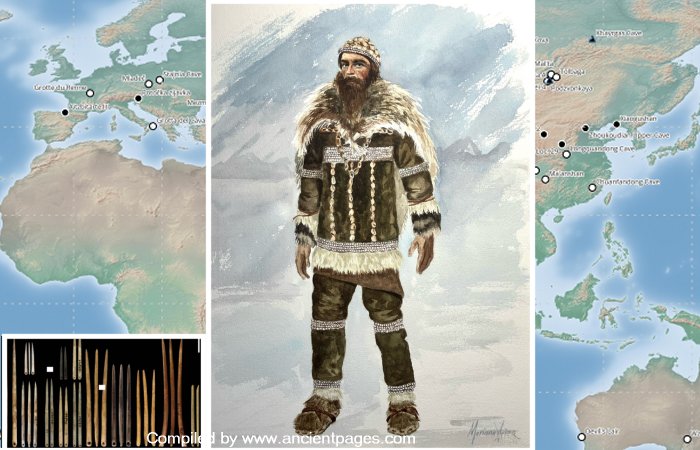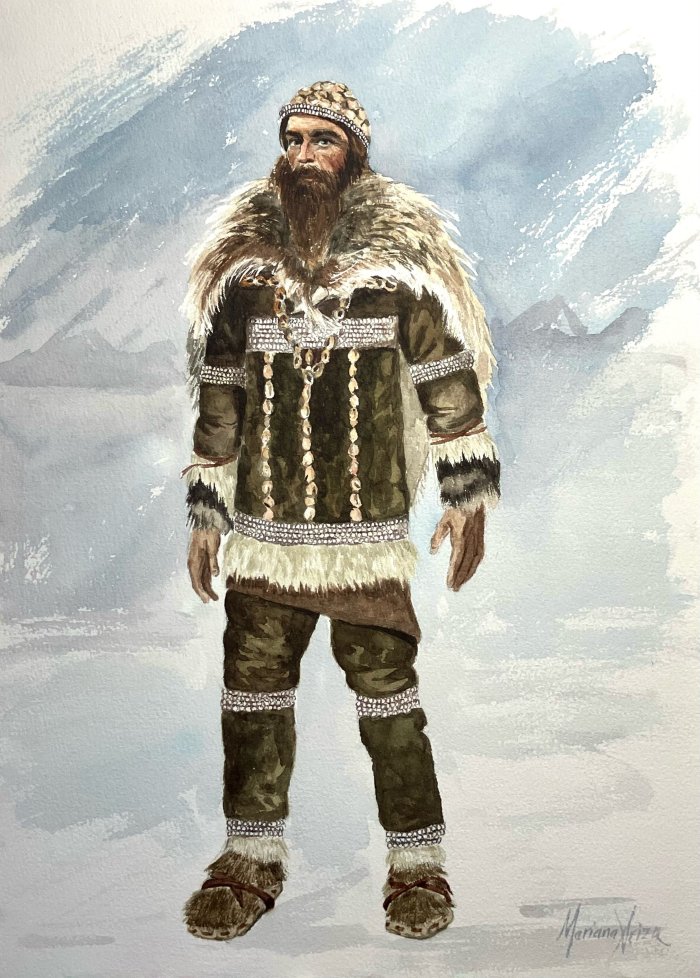Conny Waters - AncientPages.com - Being well-dressed has a long and fascinating history that extends far back into human civilization. Archaeological evidence suggests that our ancestors' appreciation for clothing goes beyond mere functionality.
Early humans initially used stone tools to prepare animal skins for thermal insulation, addressing the basic need for protection against environmental elements. However, a significant shift occurred with the invention of bone awls and eyed needles. These technological advancements allowed for the creation of fitted and adorned garments, marking a transition in the purpose of clothing.
Artist impression of decorated tailored clothing in the Upper Paleolithic. Credit: Mariana Ariza
A recent scientific study proposes that eyed needles represented a crucial innovation in human history. This technology enabled people to create more intricate and decorative clothing, serving social and cultural purposes beyond simple protection. The ability to craft detailed garments likely facilitated the expression of individual and group identities.
This development signifies a pivotal moment in human culture, when clothing evolved from a purely practical necessity to a means of self-expression and social communication. The study suggests that this shift marks the beginning of using attire to convey status, affiliations, and personal identity within social groups.
The research provides valuable insights into the origins of fashion and its role in human society, demonstrating how technological innovations in clothing production have shaped our cultural evolution over time.
"Eyed needle tools are an important development in prehistory because they document a transition in the function of clothing from utilitarian to social purposes," says Dr. Ian Gilligan, Honorary Associate in the discipline of Archaeology at the University of Sydney.
"Why do we wear clothes? We assume that it's part of being human, but once you look at different cultures, you realize that people existed and functioned perfectly adequately in society without clothes," Dr. Gilligan says.
"What intrigues me is the transition of clothing from being a physical necessity in certain environments, to a social necessity in all environments."
Eyed needles from the last ice age. Credit: Gilligan et al, 2024.
The development of eyed needles marks a significant milestone in human history. These tools first appeared approximately 40,000 years ago in Siberia and are considered one of the most iconic Paleolithic artifacts from the Stone Age. Eyed needles represent a more advanced technology than their predecessors, bone awls, which were simpler tools made from sharpened animal bones.
Bone awls were sufficient for creating fitted clothing, but eyed needles offered enhanced capabilities. These needles are essentially modified bone awls featuring a perforated hole, or "eye," which allows for the threading of sinew or other materials. This innovation greatly facilitated the sewing process.
The emergence of eyed needles likely indicates a shift towards more sophisticated clothing production. Archaeological evidence suggests that while bone awls were already being used to create tailored clothes, the introduction of eyed needles may have produced more complex, multi-layered garments. Additionally, these tools likely played a crucial role in clothing adornment, allowing for the attachment of beads and other small decorative items to garments.
"We know that clothing up until the last glacial cycle was only used on an ad hoc basis. The classic tools that we associate with that are hide scrapers or stone scrapers, and we find them appearing and going away during the different phases of the last ice ages," Dr. Gilligan explains.
"That's why the appearance of eyed needles is particularly important because it signals the use of clothing as decoration," Dr. Gilligan says. "Eyed needles would have been especially useful for the very fine sewing that was required to decorate clothing."
Locations for sites mentioned in the text with early bone awls and eyed needles. Credit: Gilligan et al, 2024.
Clothing serves multiple purposes beyond protection and comfort. It expresses individual and cultural identity, facilitates societal expansion, and enables habitation of colder regions. Shared clothing styles fostered community cohesion, while production skills contributed to human survival. The practice of covering the body persists across climates and cultures.
Dr. Gilligan's research explores the psychological aspects of wearing clothes. This multifaceted approach highlights clothing's importance in physical, social, cultural, and psychological contexts, providing insights into human adaptation, societal development, and individual expression throughout history.
See also: More Archaeology News
"We take it for granted we feel comfortable wearing clothes and uncomfortable if we're not wearing clothes in public. But how does wearing clothes impact the way we look at ourselves, the way we see ourselves as humans, and perhaps how we look at the environment around us?" Dr. Gilligan asks.
The study was published in the journal Science Advances
Written by Conny Waters – AncientPages.com Staff Writer







